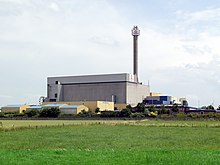SNR-300


The Fast Breeder nuclear reactor SNR-300 was built near the town of Kalkar, Germany (located in the federal state of North Rhine-Westphalia. It was completed but never taken online. It is known as one of the biggest government spending boondoggles in Germany. SNR-300 was to output 327 megawatts. The project ended up costing about 7 billion Deutsche Mark (about 3.5 billion euros or over 4 billion USD). Klaus Traube, then director of the executing company Interatom, is today one of the most prominent German opponents of the usage of nuclear power.
Planning
In the fall of 1972, Germany, Belgium and The Netherlands charged the Siemens subsidiary Interatom to build a fast breeder - still a very new technology at the time. The German government wanted to limit energy import, and, as the uranium supply in Germany was limited, a breeder facility to use the limited resources efficiently was required. The building commenced at the end of the same year.
Timeline
- 1972: The project commences.
- 1977: Increasing public doubt about the safety of nuclear energy culminates in the first demonstration, involving about 40,000 people marching in the streets of Kalkar.
- 1979: Three Mile Island suffers a partial meltdown and the increasing anti-nuclear-power bent of environmentalists causes open questioning of the project. This discussion leads to an inquiry by a commission of the Bundestag. Building is interrupted for 4 years as the commission concludes that the safety of the facility needs to be upgraded in light of the difficult to control process of fast breeders, along with concerns about the coolant (sodium, which, when brought into contact with water, explodes). The interruption along with the redesign of the safety features raise the costs of the project significantly. The local state government turns against the project.
- 1980: Protests radicalize in increasing fashion[citation needed].
- 1985: SNR-300 is completed. The reactor is taken into partial operation. The sodium coolant is already running through the coolant loop and has to be kept hot using electric heating elements so it does not solidify. The reactor is ready to receive nuclear materials. In this phase, the running costs are already more than 5 million euro per month. The state government (which has authority in matters of nuclear power and environmental issues) blocks the actual opening of the plant, against the wishes of the federal government. As elections are coming up, the German government unofficially decide not to take SNR-300 into operation just yet. After the elections the newly formed coalition has a significant environmental fraction. At this point neither the country government, nor the local state government want the facility to become operational. Plans for a second facility, SNR-2, planned to produce 1,500 megawatts, are officially cancelled around this time.
- 1986: Chernobyl disaster.
- 1991: The official cancellation of the SNR-300 is finally offered on 21 March. The demolition of parts of the facility costs another 75 million euros. The unused machinery is put on sale. The reactor core is transferred to storage elsewhere. The breeder material, already bought for the operation of the facility, is transferred to France where it is mixed into MOX fuel, which is used by a number of France's nuclear reactors.
- 1995: The facility itself is put up for auction by way of an announcement in the newspapers. The Dutch investor/developer Hennie van der Most buys the property for a mere 2.5 million euros. The site is transformed into an amusement park named Kernwasser Wunderland ("Corewater Wonderland"). It includes a hotel with 400 beds. In 2005 it was renamed into Wunderland Kalkar ("Wonderland Kalkar").
